tire type HONDA S2000 2000 1.G Owners Manual
[x] Cancel search | Manufacturer: HONDA, Model Year: 2000, Model line: S2000, Model: HONDA S2000 2000 1.GPages: 273, PDF Size: 21.58 MB
Page 9 of 273

Important Safety Precautions
You'll find many safety
recommendations throughout this
section, and throughout this manual.
The recommendations on this page
are the ones we consider to be the
most important.
Always WearY our Seat Belt
A seat belt is your best protection in
all types of collisions. Airbags
supplement seat belts, but airbags
are designed to inflate only
in a
moderate to severe frontal collision.
So even though your car is equipped
with airbags, make sure you and
your passenger always wear your
seat belts, and wear them properly.
(See page
15 ) .
Your Car is Not Recommended
for Child Passengers
Since all children are safest in the
back seat of a car, and your car does
not have a back seat, we recommend
that you
do not carry a child
passenger.
Due to the passenger's
6 Driver and Passenger Safety
airbag hazard, you should never
carry an infant in a rear-facing child
seat in this car. If a small child who
must be restrained in a forward
facing child seat, or a larger child,
must ride
in this car, be sure to
follow
all instructions and safety
warnings
in this manual. (See pages
26 and 29.)
Be Aware of Airbag Hazards
While airbags can save lives, they
can cause serious or fatal injuries to
occupants who sit too close to them,
or are not properly restrained.
Infants, young children, and short
adults are at the greatest
risk Be
sure to follow
all instructions and
warnings
in this manual. (See page
7 .)
Don't Drink and Drive
Alcohol and driving don't mix. Even
one drink can reduce your ability to
respond to changing conditions, and
your reaction time gets worse with every
additional
drink So don't drink
and drive, and don't let your friends
drink and drive, either.
Control Your Speed
Excessive speed is a major factor in
crash injuries and deaths. Generally,
the higher the speed the
greater the
risk, but serious accidents can also
occur
at lower speeds. Never drive
faster than is safe for current
conditions, regardless of the
maximum speed posted.
Keep Your Car in Safe Condition
Having a tire blowout or a
mechanical failure can be extremely
hazardous.
To reduce the possibility
of such problems, check your tire
pressures and condition frequently,
and perform
all regularly scheduled
maintenance. (See page 146
.)
Page 188 of 273
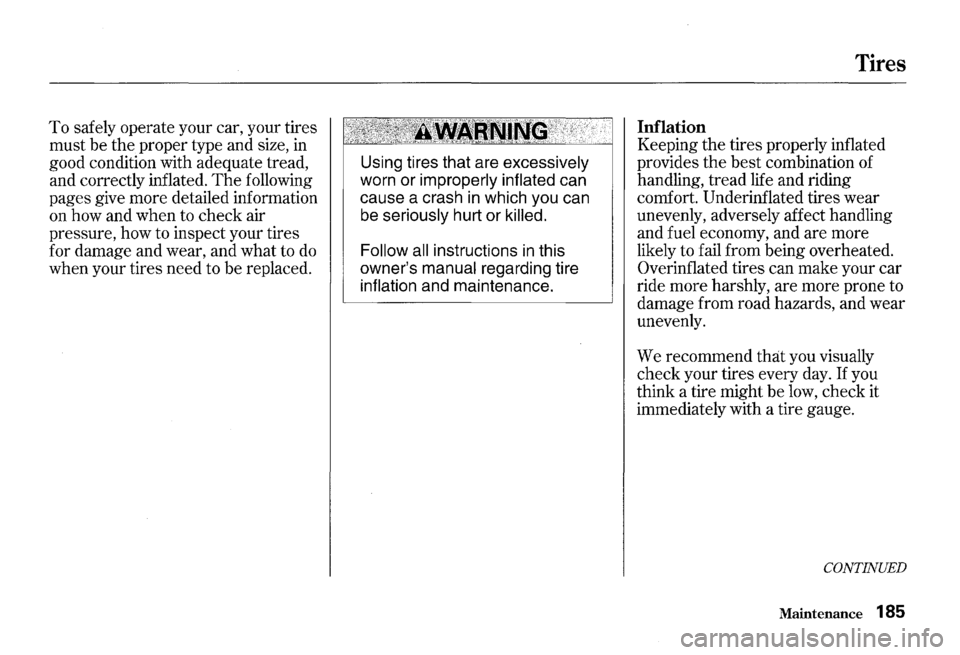
To safely operate your car, your tires
must be
the proper type and size, in
good condition with adequate tread,
and correctly inflated.
The following
pages give more detailed information
on how and when to check air
pressure, how to inspect your tires
for damage and wear, and what to
do
when your tires need to be replaced.
Using tires that are excessively
worn or improperly inflated can
cause a crash
in which you can
be
seriously hurt or killed.
Follow all
instructions in this
owner's
manual regarding tire
inflation and maintenance.
Tires
Inflation
Keeping the tires properly inflated
provides the
best combination of
handling, tread life and riding
comfort. Underinflated tires wear
unevenly, adversely affect handling
and fuel economy, and are more
likely to fail from being overheated.
Overinflated tires can make your car
ride more harshly, are more prone to
damage from road hazards, and wear
unevenly.
We recommend that you visually
check your tires every day.
If you
think a tire might be
low, check it
immediately with a tire gauge.
CONTINUED
Maintenance 185
Page 192 of 273
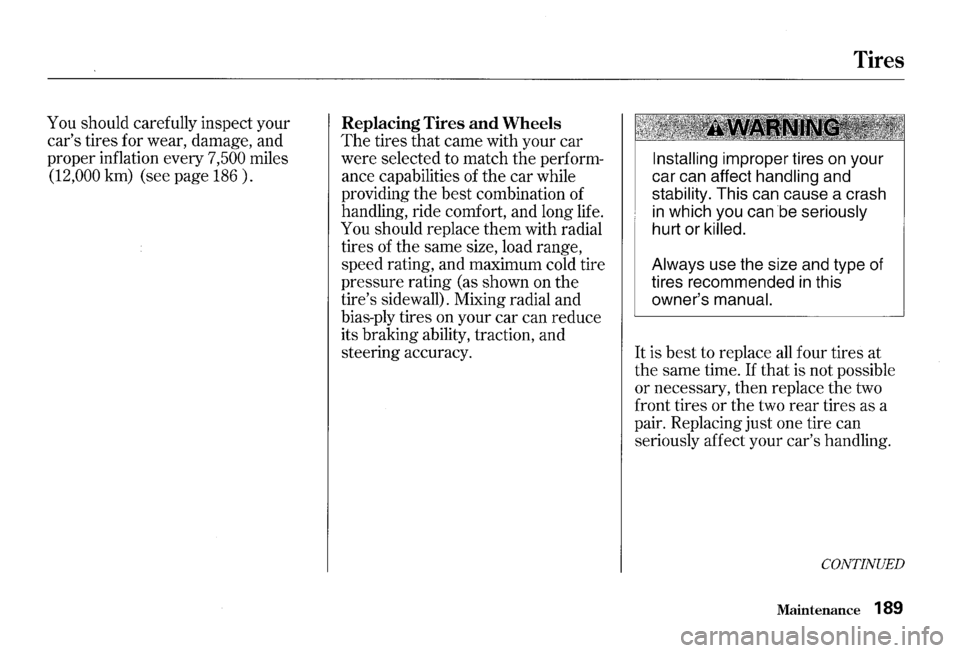
You should carefully inspect your
car's tires for wear, damage, and
proper inflation every
7,500 miles
(12,000 km) (see page 186 ) .
Replacing Tires and Wheels
The tires that came with your car
were selected to match the perform
ance capabilities of the car while
providing the best combination of
handling, ride comfort, and long life.
You should replace them with radial
tires of the same size, load range,
speed rating, and maximum cold tire
pressure rating (as shown on the
tire's sidewall). Mixing radial and
bias-ply tires on your car can reduce
its braking ability, traction, and
steering accuracy.
Tires
Installing improper tires on your
car can affect
handling and
stability. This can cause a crash
in which you can be seriously
hurt or killed.
Always
use the size and type of
tires recommended
in this
owner's
manual.
It is best to replace all four tires at
the same time. If that is not possible
or necessary, then replace the two
front tires or the two
rear tires as a
pair. Replacing just one tire can
seriously affect your car's handling.
CONTINUED
Maintenance 189
Page 194 of 273
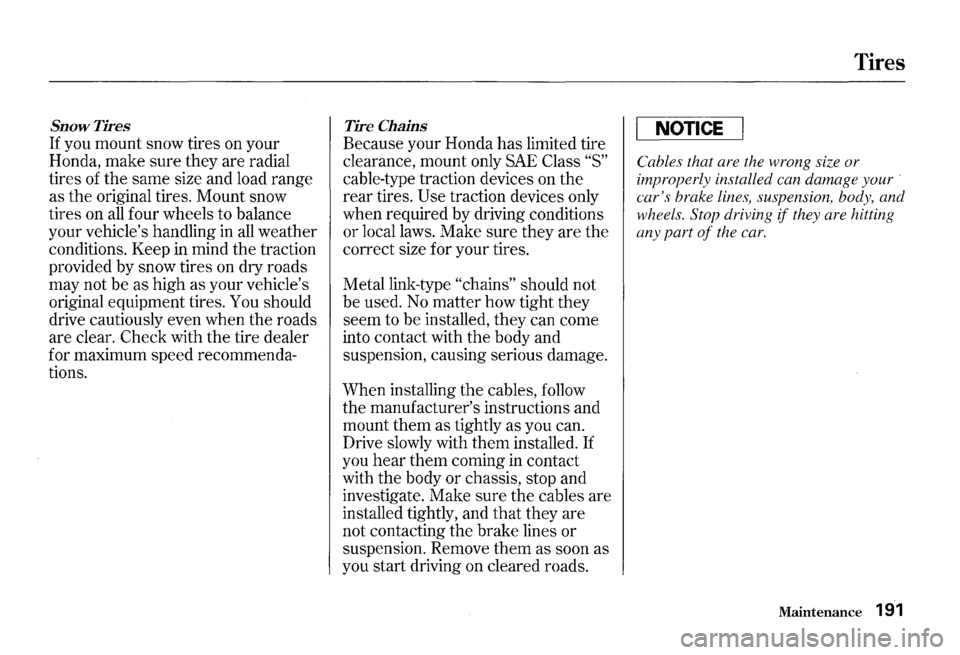
Snow Tires
If you mount snow tires on your
Honda, make sure they are radial
tires of the same size and load range
as
the original tires. Mount snow
tires on
all four wheels to balance
your vehicle's handling in all weather
conditions. Keep
in mind the traction
provided by snow tires on dry roads
may not be as high as your vehicle's
original equipment tires. You should
drive cautiously even when the roads
are clear. Check with the tire dealer
for maximum speed recommenda
tions.
Tire Chains
Because your Honda has limited tire
clearance, mount only
SAE Class "S"
cable-type traction devices on the
rear tires.
Use traction devices only
when required by driving conditions
or local laws. Make sure they are the
correct size for your tires.
Metal link-type
"chains" should not
be used.
No matter how tight they
seem to be installed, they can come
into contact with the body and
suspension, causing serious damage.
When installing
the cables, follow
the manufacturer's instructions and
mount
them as tightly as you can.
Drive slowly with them installed.
If
you hear them coming in contact
with the body or chassis, stop and
investigate. Make sure the cables are
installed tightly, and
that they are
not contacting the brake lines
or
suspension. Remove them as soon as
you start driving on cleared roads.
Tires
NOTICE
Cables that are the wrong size or
improperly installed can damage your ·
car's brake lines, suspension, body, and
wheels. Stop driving (l they are hitting
any part
of the car.
Maintenance 191
Page 241 of 273
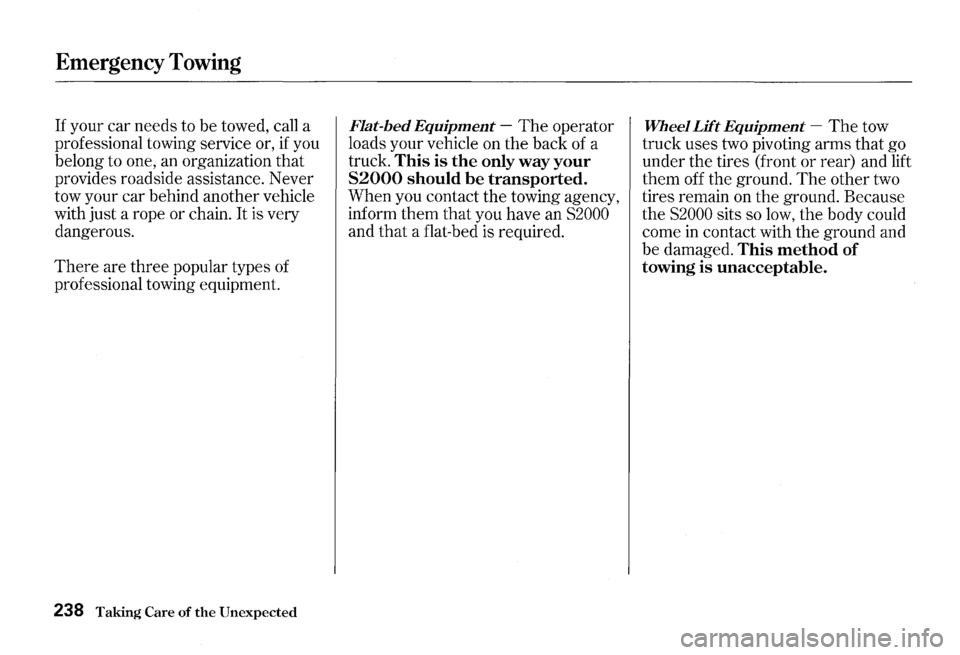
Emergency Towing
If your car needs to be towed, call a
professional towing service or,
if you
belong to one, an organization that
provides roadside assistance. Never
tow your car behind another vehicle
with just a rope or chain.
It is very
dangerous.
There are three popular types of
professional towing equipment.
238 Taking Care of the Unexpected
Flat-bed Equipment -The operator
loads your vehicle on the back of a
truck.
This is the only way your
S2000 should be transported.
When you contact the towing agency,
inform
them that you have an S2000
and that a flat-bed is required.
Wheel Lift Equipment -The tow
truck uses two pivoting arms that go
under the tires (front or rear) and lift
them off the ground. The other two
tires remain on the ground. Because
the
S2000 sits so low, the body could
come
in contact with the ground and
be damaged.
This method of
towing is unacceptable.
Page 248 of 273

Specifications
Lights Battery Headlights Hi~h 12 v -55W Capacity 12 V -36 AH/5 H R
Daytime
runnin~ li~hts 12 v - 55W(H1)
Front
turn signal lights 12 v -21 w Fuses
Rear turn si~nalli~hts 12 v -21 w Under-hood See page 235 or the fuse box Stop/Taillights 12 v -21 W/5 W cover.
Side marker lights Front 12 v -5W Interior See page 234 or the fuse label
Rear
12 v -5W attached to the inside of the fuse
Back-up lights
12 v -21 w box door under the dashboard.
License plate
li~hts 12 v -5W Interior light 12 v -5W AI' 1gnment Trunk light 12 v -5W Toe Front 0.00 in (0.0 mm)
Rear in 0.24 in (6.0 mm)
Air
conditioning Camber Front -0°30'
Refrigerant type HFC-134a (R-134a)
Rear -F30'
Charge quantity 19.4-21.2 oz (550-600 ~) Caster Front 60
Lubricant type SP-10
Tires
Size Front
205/55R16 89W
Rear 225/50R16 92W
Spare Tire T125/70D16
96M
Pressure Front 32
psi (220 kPa , 2.2 kgf/cm2
)
Rear 32 psi (220 kPa , 2.2 kgf/cm2
)
Spare Tire 60 psi (420 kPa , 4.2 k~f/cm2)
Technical Information 245
Page 260 of 273
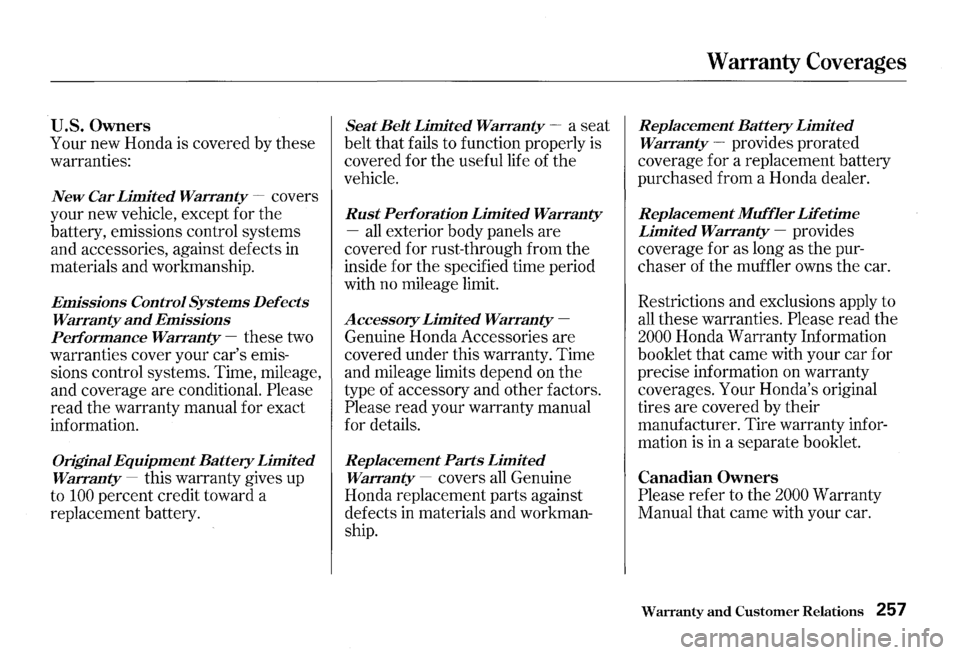
U.S. Owners
Your new Honda is covered by these
warranties:
New Car Limited Warranty -covers
your new vehicle, except for the
battery, emissions control systems
and accessories, against defects
in
materials and workmanship.
Emissions Control Systems Defects
Warranty and Emissions
Performance Warranty-these two
warranties cover your car's emis
sions control systems. Time, mileage,
and coverage are conditional.
Please
read the warranty manual for exact
information.
Original Equipment Battery Limited
Warranty -this warranty gives up
to
100 percent credit toward a
replacement battery.
Seat Belt Limited Warranty -a seat
belt that fails to function properly is
covered for the useful life of
the
vehicle.
Rust Perforation Limited Warranty
-all exterior body panels are
covered for rust-through from the
inside for the specified time period
with no mileage limit.
Accessory Limited Warranty
Genuine Honda Accessories are
covered under this warranty. Time
and mileage limits depend on
the
type of accessory and other factors.
Please read your warranty manual
for details.
Replacement Parts Limited
Warranty -covers all Genuine
Honda replacement parts against
defects in materials and workman
ship.
Warranty Coverages
Replacement Battery Limited
Warranty-provides prorated
coverage for a replacement battery
purchased from a Honda dealer.
Replacement Muffler Lifetime
Limited Warranty -provides
coverage for as long as the pur
chaser of the muffler owns the car.
Restrictions and exclusions apply to
all these warranties. Please read the
2000 Honda Warranty Information
booklet that came with your car for
precise information on warranty
coverages. Your Honda's original
tires are covered by their
manufacturer. Tire warranty infor
mation is
in a separate booklet.
Canadian Owners
Please refer to the 2000 Warranty
Manual that came with your car.
Warranty and Customer Relations 25 7
Page 270 of 273
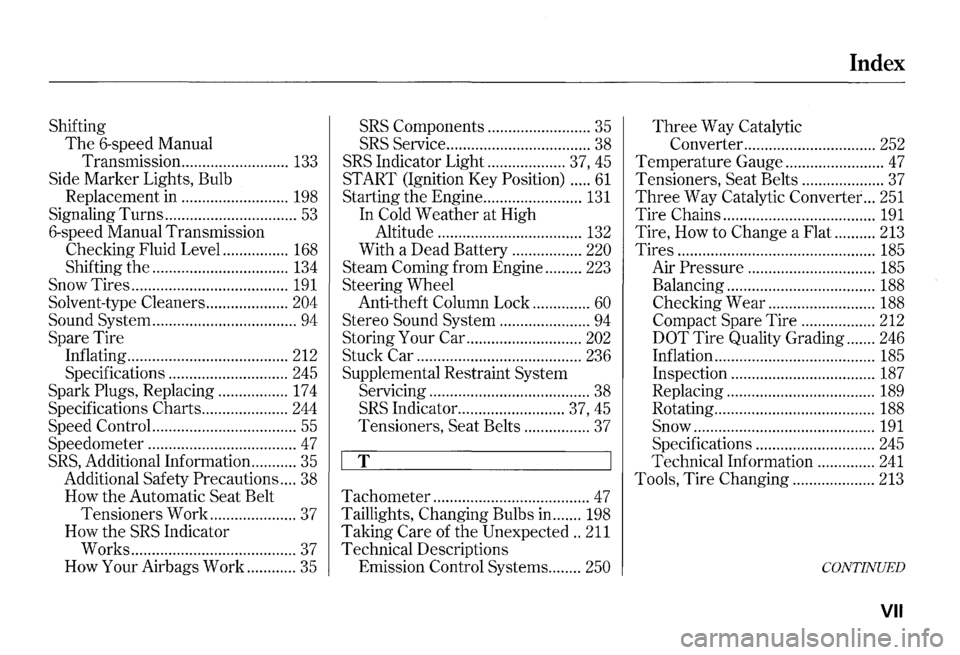
Shifting
The 6-speed Manual
Transmission ..........................
133
Side Marker Lights, Bulb
Replacement in .......................... 198
Signaling
Turns ................................ 53
6-speed Manual Transmission
Checking Fluid Level ................
168
Shifting the ................................. 134
Snow Tires ...................................... 191
Solvent-type Cleaners .................... 204
Sound System ................................... 94
Spare Tire
Inflating .......................................
212
Specifications ............................. 245
Spark Plugs, Replacing ................. 17 4
Specifications Charts ..................... 244
Speed Control... ................................ 55
Speedometer .................................... 4 7
SRS, Additional Information ........... 35
Additional Safety Precautions .... 38
How the Automatic Seat Belt
Tensioners
Work ..................... 37
How the SRS Indicator
Works ........................................
37
How Your Air bags Work ............ 35
SRS Components ......................... 35
SRS Service ................................... 38
SRS Indicator Light ................... 37, 45
START (Ignition Key Position) ..... 61
Starting the Engine ........................ 131
In Cold Weather at High
Altitude ...................................
132
With a Dead Battery ................. 220
Steam Coming from Engine ......... 223
Steering Wheel
Anti-theft Column Lock ..............
60
Stereo Sound System ...................... 94
Storing Your Car ............................ 202
Stuck Car ........................................ 236
Supplemental Restraint
System
Servicing
....................................... 38
SRS Indicator .......................... 37, 45
Tensioners, Seat Belts ................ 37
T
Tachometer ...................................... 4 7
Taillights, Changing Bulbs in ....... 198
Taking Care of
the Unexpected .. 211
Technical Descriptions
Emission Control
Systems ........ 250
Index
Three Way Catalytic
Converter ................................
252
Temperature Gauge ........................ 4 7
Tensioners,
Seat Belts .................... 37
Three Way Catalytic Converter ... 251
Tire Chains ..................................... 191
Tire, How to Change a Flat .......... 213
Tires ................................................ 185
Air Pressure ............................... 185
Balancing .................................... 188
Checking Wear .......................... 188
Compact Spare Tire .................. 212
DOT Tire Quality Grading ....... 246
Inflation .......................................
185
Inspection ................................... 187
Replacing .................................... 189
Rotating ....................................... 188
Snow ............................................ 191
Specifications ............................. 245
Technical Information ..............
241
Tools, Tire Changing .................... 213
CONTINUED
VII